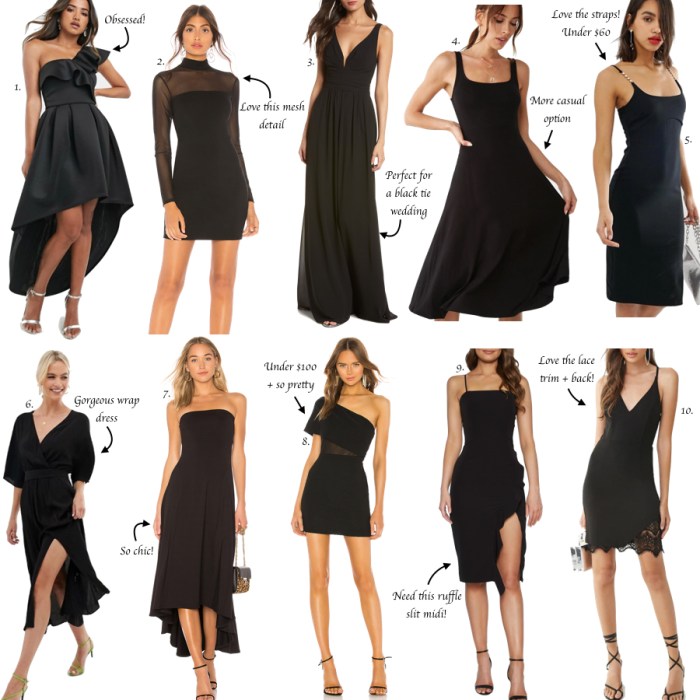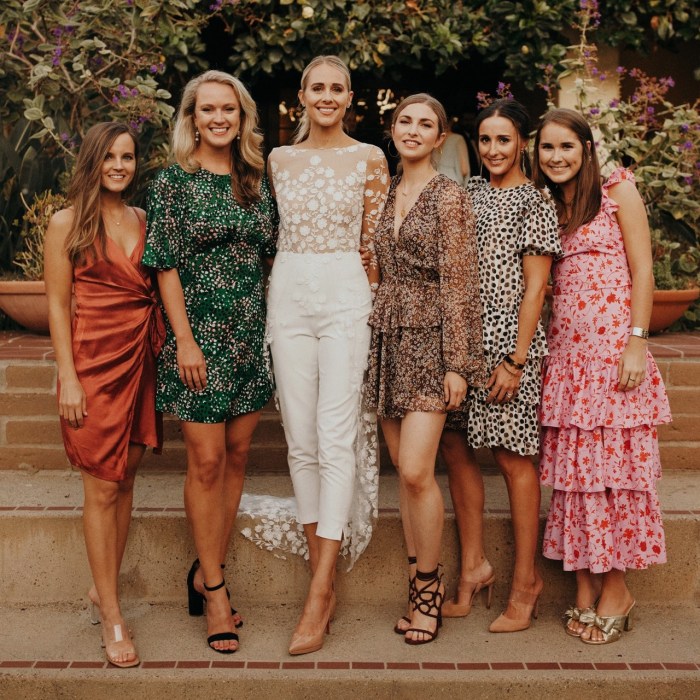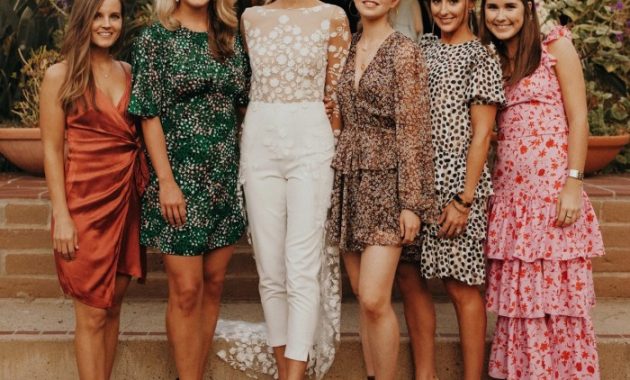Understanding Wedding Attire Etiquette: Wedding Guest Etiquette Dress Code
Wedding guest etiquette dress code – Navigating wedding dress codes can sometimes feel like deciphering a secret code. This guide provides clarity on common dress code terms, venue considerations, and how to avoid common fashion faux pas, ensuring you arrive looking stylish and respectful.
Common Wedding Dress Code Terminology
Understanding the terminology is crucial for choosing appropriate attire. Different dress codes indicate varying levels of formality.
| Dress Code | Description | Appropriate Attire | Inappropriate Attire |
|---|---|---|---|
| Black-Tie | Formal evening attire; the most formal dress code. | Floor-length gowns for women; tuxedos or dark suits with bow ties for men. | Cocktail dresses, jeans, casual shoes |
| Cocktail | Semi-formal; allows for a range of styles. | Cocktail dresses, dressy jumpsuits, suits or sport jackets for men. | Jeans, t-shirts, overly casual attire |
| Casual | Relaxed and informal; comfortable yet presentable. | Sundresses, khakis, button-down shirts, nice jeans. | Ripped jeans, athletic wear, anything too revealing. |
| Semi-Formal | Falls between cocktail and casual; adaptable to various settings. | Knee-length dresses, dress pants and a blouse for women; dress pants and a button-down shirt for men. | Jeans, t-shirts, sneakers (unless specifically stated) |
Less common or ambiguous descriptions require careful interpretation. Consider the overall tone of the invitation and the couple’s known style. If in doubt, it’s always best to err on the side of slightly more formal attire.
Venue and Time of Day Considerations
The wedding venue and time of day significantly impact appropriate attire choices. Beach weddings call for different attire than ballroom weddings.
- Dos: Consider the weather, terrain, and overall ambiance of the venue. Choose comfortable shoes appropriate for the setting.
- Don’ts: Avoid attire unsuitable for the weather (e.g., heels on a beach) or that clashes with the venue’s style (e.g., a formal gown at a casual outdoor wedding).
A morning wedding might suggest a lighter, more casual outfit compared to an evening wedding, which generally calls for more formal attire. A garden wedding in the afternoon might call for a midi dress and sandals, while a black-tie evening wedding at a ballroom requires a floor-length gown and heels.
Respecting the Couple’s Wishes
Adhering to the couple’s dress code preferences demonstrates respect for their vision. Even subtle cues, like the invitation’s design or the wedding website, can provide hints about the desired level of formality.
If the dress code is unclear or absent, reaching out to a member of the wedding party for guidance is acceptable. It’s always better to ask than to risk showing up inappropriately dressed.
Scenario: An invitation mentions a “garden party” but doesn’t specify a dress code. A guest might choose a stylish sundress or a knee-length floral dress, avoiding anything too casual or overly formal.
Avoiding Fashion Faux Pas

Source: themilleraffect.com
Certain attire choices should generally be avoided at weddings. Understanding these common mistakes ensures you remain respectful and appropriately dressed.
- Avoid wearing white (unless specifically requested by the couple).
- Avoid overly revealing clothing.
- Avoid wearing black (unless it’s a black-tie event or the couple specifies it’s acceptable).
- Choose comfortable and practical attire; you’ll be doing a lot of socializing!
- Appropriate Accessories: Elegant jewelry, a clutch, a stylish hat (depending on the venue and dress code).
- Inappropriate Accessories: Anything overly flashy or distracting, excessively large bags, overly casual footwear (unless appropriate for the dress code).
Accessorizing and Personal Style, Wedding guest etiquette dress code

Source: greenweddingshoes.com
Accessories can elevate an outfit and add a touch of personal style while still remaining respectful of the wedding’s formality. Subtlety is key; avoid anything that overshadows the bride.
- A statement necklace with a simple dress.
- A stylish belt to cinch a waist.
- A colorful scarf to add a pop of color.
- Elegant earrings.
Avoid overly large or flashy jewelry, especially if the wedding is formal. Choose accessories that complement your outfit and the overall style of the wedding.
Illustrating Appropriate and Inappropriate Outfits
Here are examples to illustrate appropriate and inappropriate attire choices.
Appropriate Cocktail Attire (3 examples):
1. A knee-length, A-line dress in a jewel tone, made of a flowing fabric like silk or crepe, paired with elegant heels and delicate jewelry.
2. A sophisticated jumpsuit in a rich color like emerald green or navy, with a tailored fit and elegant accessories like a statement belt and clutch.
3. A midi dress with a feminine print, made from a lightweight fabric like cotton or linen, paired with comfortable wedges and a straw hat (for an outdoor wedding).
Inappropriate Black-Tie Attire (3 examples):
1. A short, sparkly dress – Black-tie events call for floor-length gowns.
2. Jeans and a nice top – This is far too casual for a black-tie event.
3. A brightly colored, printed maxi dress – While maxi dresses can be appropriate, this would be too casual and informal for a black-tie wedding.
Question Bank
Can I wear a jumpsuit to a wedding?
Jumpsuits can be appropriate, depending on the dress code and formality of the wedding. A sophisticated jumpsuit in a suitable fabric and color is often acceptable for cocktail or semi-formal events. Avoid overly casual or revealing styles.
What if the invitation doesn’t specify a dress code?
Understanding wedding guest etiquette dress code is crucial for showing respect to the happy couple. Knowing the dress code helps you choose an appropriate outfit, avoiding anything too flashy or casual. If you’re looking for inspiration for your own special day, perhaps checking out the beautiful selection of wedding dresses available in Yakima, WA, at wedding dresses yakima wa , might be helpful.
Returning to guest etiquette, remember to always consider the overall wedding style and venue when selecting your attire.
If the invitation lacks a dress code, a semi-formal outfit is usually a safe bet. Consider the time of day and venue for guidance. It’s always best to err on the side of slightly more formal than less formal.
Is it okay to wear white to a wedding?
Generally, it’s best to avoid wearing white to a wedding, as it’s traditionally reserved for the bride. Unless specifically instructed otherwise by the couple, opt for a different color.
What about wearing black to a wedding?
Black is generally acceptable, especially for evening weddings or black-tie events. However, choose a stylish black outfit and avoid anything too somber or reminiscent of mourning attire.

